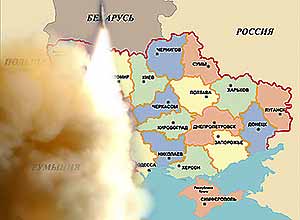July 03, 2007 (the date of publication in Russian)
Maxim Kalashnikov
THE NEAREST THREAT
A NATO overtake of Ukrainian military bases is a larger menace than new ABM deployment
 In Alexander Pushkin's ballad, Prince Oleg, the founder of the ancient Russian statehood, "embraced death from his steed": he was stung by a serpent which used the dead horse’s skull as a convenient shelter.
In Alexander Pushkin's ballad, Prince Oleg, the founder of the ancient Russian statehood, "embraced death from his steed": he was stung by a serpent which used the dead horse’s skull as a convenient shelter.
The prospect of Ukraine's entry in NATO is often perceived carelessly. Since the USSR's disintegration, the once enormous potential of war materiel and munitions, accumulated on the territory of a newly independent Ukraine, has been partly sold out and partly embezzled. Today, Ukraine's armed forces are combat-ineffective. The Navy and the Air Forces are tied up to their bases; the miserably thin budget does not meet even elementary requirements of defense. There is nothing to fear of – until Ukraine's military (especially air force) facilities are given the works by the US forces.
The vividly discussed possibility of deployment of US anti-ballistic missile systems in Ukraine is not the most significant menace for Russia, as ABM objects may be easily swept away by the first missile strikes. The infrastructure of the air force and the Navy, extensively developed in the Soviet era, represent a much more sensitive threat.
According to the recently published research paper published by Ukrainian author Alexander Shirokorad (Russia and Ukraine: When Cannons Start Speaking, Moscow, AST, 2007, p.397), Ukraine possesses 85 military airdromes (including 4 extra class; 55 first-class, and 25 second-class airfields). In addition, there are also 26 airdromes presently used by civil aviation.
This potential is perfectly convenient for rapid deployment of attack aircrafts, capable of reaching Moscow for an hour of flight. In addition to this semistrategic aviation, NATO forces may deploy refuelers, electronic warfare (EW) aircrafts and aerial radars of Hokai and Sentry models. In 1991 and 2004, the airdromes of Saudi Arabia were used in this way for delivering paralyzing air strikes upon Iraq. For a period of a month, poorly equipped airfields (with nothing but concrete landing strips) were upgraded into perfect modern bases – like Al Harj south-eastward from Riyadh. The capital city's civil airdrome was used as well, becoming a base for deployment of Sentry (AWACS) aircrafts and aerial tankers.
In order to neutralize a network of aircraft basing of this scale, Russia would require around 200 missiles with nuclear ammunition, in order to robustly destroy the adversary's "vespiaries". Another option is to use conventional high accuracy missiles, in a quantity not smaller than 500.
Ukraine's membership in NATO would definitely suggest elimination of the Black Sea Fleet, as it has got no other place of basing except the havens of Crimea. Novorossiysk does not meet the requirements: even in the era of sailboats, it was not used as a Navy base. Historically, Crimea was a subject of large-scale battles exactly due to the convenience of its havens for basing the Navy. That was the subject of the war efforts undertaken under command of Feldmarshal Suvorov and Prince Potemkin.
The partition of the Black Sea Fleet between Russia and Ukraine has brought the Navy potential to a hapless condition. The "striped" partition of the coastline infrastructure enables the adversary to easily overtake it. The lied-up ships are extremely vulnerable: on can equally run them foul or destroy their propeller-rudder systems. Construction of military bases did not suggest that they find themselves on the territory of a NATO country.
The havens, with their perfect infrastructure, would become a luxurious gift to the US forces and their allies – in Odessa, Ochakov, Skadovsk, Feodosia, Balaklava, Sevastopol, Donuzlav, Kerch and elsewhere. Some of these bases may be used even for aerocarriers. From the Crimean havens, they would be able to enter the Azov Sea, from where US sea-based cruise missiles could easily reach the strategically vital centers of Russia's Central Region. Moreover, Russia would find itself gripped, as the same Tomahawks could attack from the Baltic coastline of Lithuania, Latvia, and Estonia. In this way, NATO would be able to establish control not only over the export pipelines connecting East Siberia with Europe but also the marine oil trade route from Novorossiysk – along with the Russia-Turkey "Blue Stream" gas pipeline.
Besides, Ukraine could be made into a stronghold for deployment of land forces (one command moving towards Moscow from here and the other from the Baltic).
In case of Russia's withdrawal from INF Treaty, NATO will be able to deploy its mid-range missiles in Ukraine, at the distance of several minutes of flight from Moscow. In this case, the Russian Federation would have to build a new capital city in the area of Krasnoyarsk to secure itself from the described assault.
This means that Ukraine should not be viewed by Russia as a "cut-off chunk", floating (or sinking) on its own accord. The above explicated military aspects alone require primary attention to the relations between Moscow and Kiev, as an unalienable element of any of Russia’s development programs, including those entitled as "priority national projects". Beyond official diplomacy, corporate interests and particular political games, these relations are to be upgraded in the framework of a comprehensive endeavor, which is to involve not only technologies but also humanitarian sciences, essential for the revival of the spirit of common thinking, common culture and common responsibility, engraved in the glory of ancestors.
Number of shows: 1437
rating:
3.3
 ENG
ENG 

 ENG
ENG 
